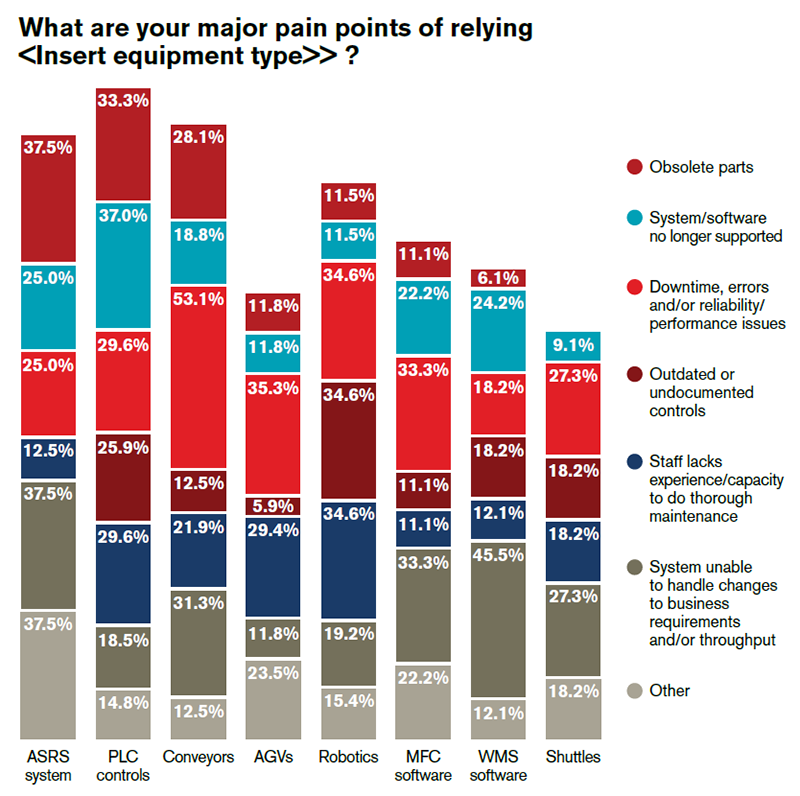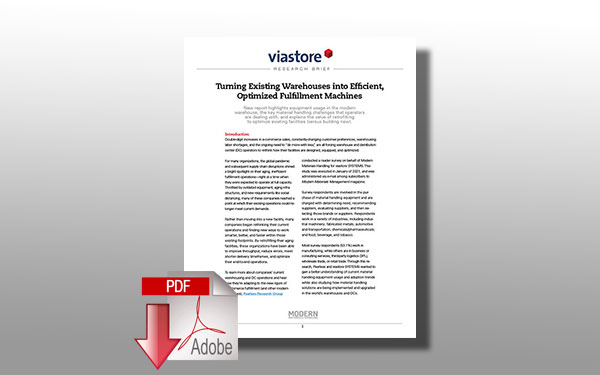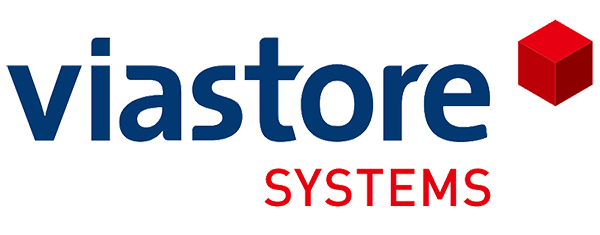Updating Existing Warehouse Equipment and Software Can Mitigate Today’s Fulfillment Challenges

Organizations can future-proof their current facilities in a way that optimizes material flow, enhances efficiencies, and makes better use of existing space.
Inefficient Warehouses
Did you know that the average age of warehouses in the U.S. is 34 years old? That means most of today’s fulfillment centers have been around longer than the concept of e-commerce.
And what about the material handling equipment, systems, and software in those facilities? In many cases, anywhere from 15% to 37% of these critical technologies are at least 10 years old.
We know this because we recently worked with Modern Materials Handling and Peerless Research Group, to find out more about how today’s distribution and fulfillment operations are utilizing their equipment.
The report: “Turning Existing Warehouses into Efficient, Optimized Fulfillment Machines,” was released today. It examines current system, software, and equipment usage in today’s warehouses.
Of particular interest was determining how these operations are managing the increased demands on their aging equipment — driven by the COVID-19 pandemic — and the resulting challenges. Additionally, the report delves the value of modernizing existing equipment and systems, rather than moving into a new facility or investing in new equipment. Here are a couple of key findings from the study:
- The two technologies most used in today’s warehouses — by 43.4% of respondents — are conveyors and warehouse management software (WMS). They’re followed by controls (34.3%), robotics (30.3%), and automatic guided vehicles (AGVs) (20.2%).
- As for the original installation date of those technologies, more than one-third of respondents (36.6%) report that their WMS was implemented at least a decade ago. Likewise, another one-third of survey participants say their conveyor systems were installed 10 or more years ago. The third equipment type providing the longest-term service is automated storage and retrieval systems (ASRS), with 27.3% reporting implementation of at least 10 years ago.
Aging Equipment Poses Numerous Challenges
Relying on equipment that was commissioned in 2011 (or earlier) is not helping operations managers meet their throughput and productivity needs. When asked about the specific pain points associated with installing, using, and maintaining these older systems, respondents noted the following:
- 37.5% say their ASRS is plagued by obsolete parts and cannot handle changes in throughput, as well as “other” unspecified issues.
- 37.0% note their controls are no longer supported by the original equipment manufacturer (OEM) or supplier.
- 53.1% report that their conveyor systems frequently suffer from downtime, errors, and performance issues.
- 35.3% of AGV owners note downtime, errors, and/or reliability and performance problems.
- 34.6% of those with robotic systems struggle with downtime and errors, outdated or undocumented controls, and inexperienced staffers who lack the qualifications to provide thorough maintenance.
- 45.5% say their WMS is unable to handle changes to business requirements and/or throughput.
- 27.3% of shuttle users struggle with downtime and performance errors, and report that the equipment cannot handle changing business or throughput needs.
Modernization Addresses Current Fulfillment Needs
Although nearly 60% of the surveyed companies report using internal service teams to provide routine preventative maintenance — and another 23.4% contract with their supplier for such services — even the best-maintained systems grow older with each passing year.

Meanwhile, the capabilities, functionality, and inter-connectivity of newer technologies and software have grown exponentially in the past decade. Perhaps, then, it’s no surprise that nearly 60% of respondents would prefer to scrap their existing equipment and replace it with new technologies and software.
The reality, however, is that many companies are reluctant or unable to make that degree of investment given the recent uncertainties in the economy. Further, many equipment manufacturers and suppliers have been inundated with new automation orders, pushing lead times out farther than ever before.
When factoring in both time and money, more than one-third (33.9%) of those surveyed say they’d prefer to enhance the equipment they already have through a modernization, upgrade, or retrofit.
That’s not to say these operations won’t adopt new technologies, particularly automation, in the future. Indeed, 67.9% say they will. But in the interim, leveraging a strategic modernization plan will help an operation boost throughput, meet shorter shipping deadlines, support their existing workforce, and optimize their end-to-end workflows.
Critically, 92.7% of survey respondents say that engaging an experienced solutions provider who can support both new automation and upgrades of existing equipment is important. Finding a partner whom you can rely on to help leverage your current assets — in conjunction with new components, technologies, and software — will help you meet your customers’ needs with flexibility and agility in a perpetually shifting marketplace.
That’s why viastore SYSTEMS offers a broad range of systems and equipment modernization services. With you, we develop a tailored upgrade roadmap that optimizes the interaction of aging equipment with new technologies.
You will be able to extend the useful life of your system and remain competitive without the expense or disruption of a major capital equipment implementation. You’ll also see improved availability, reduced downtime, lower repair and energy costs, readily obtainable spare parts, and improved preventive maintenance and remote support.
Related Resource
Turning Existing Warehouses into Efficient, Optimized Fulfillment Machines
New report highlights equipment usage in the modern warehouse, the key material handling challenges that operators are dealing with, and explains the value of retrofitting to optimize existing facilities (versus building new). Download Now!
Article Topics
viastore systems News & Resources
Updating Existing Warehouse Equipment and Software Can Mitigate Today’s Fulfillment Challenges Turning Existing Warehouses into Efficient, Optimized Fulfillment Machines Automation as a Cold Chain Labor Strategy Best Practices for a Successful Cold Storage Automation Implementation Automation: An Effective Labor Strategy in Cold Chain Warehousing and Distribution AS/RS Modernization Reduces Downtime and Saves Thousands of Dollars at Food Service Facility Automation Considerations for Frozen Product Storage More viastore systemsLatest in Warehouse|DC
Biden Gives Samsung $6.4 Billion For Texas Semiconductor Plants Walmart Unleashes Autonomous Lift Trucks at Four High-Tech DCs Plastic Pollution is a Problem Many Companies are Still Ignoring The Harsh Reality for Amazon and Walmart Warehouse Workers Supply Chain Stability Index: “Tremendous Improvement” in 2023 AI Not a Priority for Retailers and CPG Companies US Government Commits $6.6B to Boost Semiconductor Production More Warehouse|DC














